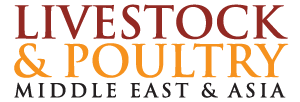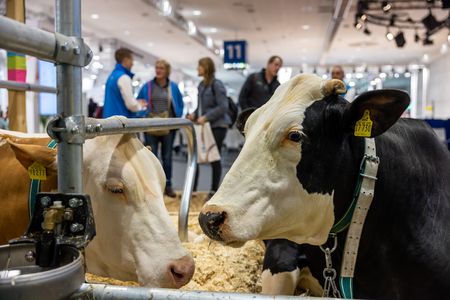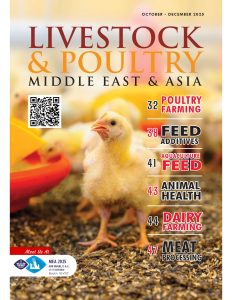EuroTier 2024: 12 to 15 November 2024 in Hanover, Germany – Guiding theme at the trade fair: “We innovate animal farming” – Reducing land for feed cultivation applying efficient feed management – Exploring knowledge and solutions for alternative protein sources for animal nutrition
In the debate about securing food for a growing world population, animal feed is an increasingly important topic. In the future, feedstuffs that are not in direct competition with human food will be prioritised. Livestock farmers can already now reduce the amount of land required for feed cultivation by actively applying efficient feed management measures. Protein sources that can replace rapeseed and soya and other conventional feedstuffs are increasingly viewed as an attractive alternative. The topic of alternative feed will be explored in-depth at EuroTier 2024, which will take place in Hanover, Germany, from 12 to 15 November 2024.
The amount of arable land available per person worldwide is decreasing at a great rate. While some four billion people had available 3,800 square metres per person in 1970, by 2023 less than half of that was available – 1,800 square metres – but serving twice as many people – and the trend is continuing. The situation is being exacerbated by the growing world population, but also as a result of increasing meat consumption due to rising incomes. This is leading to a further increase in livestock and, therefore, also to the amount of land required for animal husbandry.
Competition for food between animals and humans
In order to ensure a sustainable food supply for the population in the long term, existing resources must be utilized more efficiently and alternatives to existing food sources are needed. The questions of how to feed animals must be addressed. Farm animals currently consume around a third of the world’s grain harvest and more than 80 percent of the world’s soya bean production, but this must be considered in the overall context of land use and efficient use of resources. There are other influencing factors. Nevertheless, the competition between humans and animals for scarce food resources must be avoided or at least reduced.
This competition for food can be countered in different ways:
- Biomass must be used in order of priority: firstly for humans, secondly for animals directly, and thirdly in a biomass tank.
- Biomass that cannot be eaten by humans should first be utilised for feeding livestock.
- Livestock farmers must control the biomass flow. They should know how to maximise the harvest and the quanty of feed and how to minimise losses in order to reduce the amount of land required for the cultivation of fodder crops.
- Alternative protein sources, such as insects or algae with low agricultural land requirements, can also be used for the production of feed for livestock such as cattle, pigs or poultry, depending on how easy it is to produce a biomass as feed for these species.
Increase the use of biomass unsuitable for human consumption as animal feed
One way to reduce food competition is to make use of biomass that is unsuitable for human consumption to feed animals. The majority of agricultural biomass cannot be eaten by humans, such as fodder or the produce of catch crops. But even with crops, the majority of harvested biomass is not suitable as food. Only just under 20 per cent of plant food can be eaten directly by humans. By using biomass unsuitable for humans for livestock, almost the same amount of food can be produced from the same amount of arable land by livestock without any competition with humans for food.
Ruminants play a special role in this context, as their unique forestomach system, developed over the course of evolution, enables them to break down complex carbohydrates, which are almost indigestible to both humans and monogastric farm animals such as pigs and poultry. The importance of grassland for the preservation of the landscape of the countryside also plays a role.
One challenge for the future is to optimise the feed efficiency of biomass not suitable for humans, for example through appropriate breeding, for example low input – high output. This is a challenge for plant breeders, but also for manufacturers of animal feed and processing technology.
Minimising losses from the field to the animal
Unfortunately, minimizing losses from the field to the animal is still a long way off. However, cattle farmers can already do something actively today and must recognise their necessity of reducing feed losses on their farms. Dry matter losses between field and animal can amount to up to 30 per cent and in some cases even more. Livestock farmers should therefore know their land’s gross yield and their net yield. In other words, they should know and specifically measure the yield of their crops and why they make losses and how much is lost on the long journey from field to silo to trough and ultimately to the cow’s mouth.
In many forage farms, harvested quantities and forage losses have not yet been recorded due to a lack of weighing facilities such as weighbridges on the premises or because of time pressure during harvesting. Forage losses in particular are usually significantly underestimated. Sufficiently accurate forage planning can only be achieved through yield management. The following principle applies: Only those who measure can also control. If losses are reduced, less land needs to be cultivated for fodder crops or more animals can be fed with the yield from the same area. This also has a considerable impact on the economic and environmental evaluation of feed production.
Alternative protein sources as a solution?
In the debate about avoiding food competition, possible alternative sources of protein, fat and carbohydrates for animal feed have entered the discussion. One area is the use of insects as animal feed. Another alternative food source under consideration is plant biomass from aquatic sources, especially algae, which do not require agricultural land. EuroTier 2024 reflects the developments in this area and presents the latest alternative protein sources at the “Inhouse Farming – Feed & Food Show” for the self-contained agricultural and food systems of the future.
Insects: Important questions remain
Insects and their larvae are not only rich in protein, their fat content can also be considerable. Since August 2021, insect protein has been authorised as supplementary feed for pig and poultry (EU) No. 2021/1372 to EU Regulation 999/2011. There are good arguments in favour of insects as animal feed, including black soldier fly or mealworms. They have considerable breeding potential, require little space for reproduction and in some cases have a broad feed spectrum.
However, important questions still remain. For example, many insect species eat the same things as humans. A suitable may be to use insects that feed on substances including biomass that are inedible to humans. However, this is associated with a significantly lower quality of feed and therefore also lower economic efficiency. Double transformation losses – feed for the insects and for the livestock – also require highly efficient production of insect protein as feed. Finally, hygiene and safety issues still need to be addressed. For example, according to current feed regulations, farmed insects may only be fed with authorised feedstuffs and not with waste.
Algae: Less suitable for widespread use
A distinction is made between microalgae and macroalgae. Microalgae can be particularly useful for protein production. Examples show that they can be used as a soya substitute in animal feed. Macroalgae, on the other hand, such as brown, green and red algae, are mainly suppliers of carbohydrates. However, the carbohydrates in macroalgae are in a form that is largely enzymatically indigestible for farm animals. The extent to which the accumulation of undesirable substances in the algae plays a role must also be considered. Large-scale use as animal feed is therefore out of the question for this important area for the time being.
EuroTier 2024: innovative animal feed at the world’s leading trade fair for professional livestock farming
Biomass must not be wasted in order to avoid competition for food as a result of increasingly scarce arable land. For this reason, agricultural production from plate to trough must be better and more sustainably orientated. One way is to utilise biomass unfit for human consumption even more intensively and in a more targeted manner for livestock. Another starting point is on-farm feed management. Here, land can be gained for food production by reducing losses from field to trough. Alternative protein sources such as insects and algae look promising for the future, but important questions still need to be addressed before widespread use. At EuroTier 2024, leading companies from the national and international animal feed industry and start-ups will be demonstrating how innovative feed and processes can be used to meet the demands of responsible livestock feeding.
For More Information :- – www.eurotier.com



















